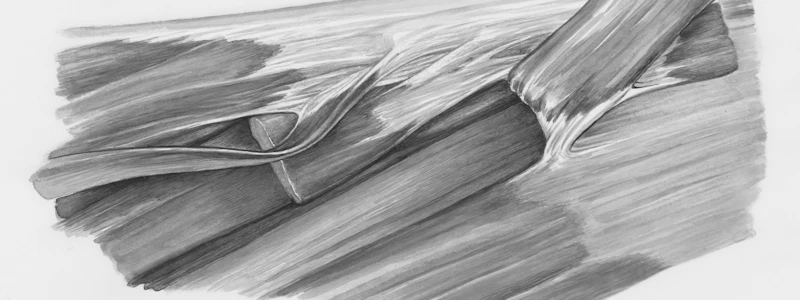Podcast
Questions and Answers
Which phase of mitosis is characterized by the alignment of chromosomes?
Which phase of mitosis is characterized by the alignment of chromosomes?
- Prophase
- Metaphase (correct)
- Anaphase
- Telophase
What is the end result of meiosis?
What is the end result of meiosis?
- Four identical haploid cells
- Four genetically diverse haploid cells (correct)
- Two genetically diverse diploid cells
- Two identical diploid cells
What is the primary purpose of mitosis?
What is the primary purpose of mitosis?
- To divide germ cells
- To repair damaged tissues (correct)
- To produce sex cells
- To create genetic diversity
Which of the following structures undergoes meiosis?
Which of the following structures undergoes meiosis?
In which stage of mitosis do chromatids separate?
In which stage of mitosis do chromatids separate?
What function is primarily associated with epithelial tissue?
What function is primarily associated with epithelial tissue?
Which type of muscular tissue is responsible for involuntary movements?
Which type of muscular tissue is responsible for involuntary movements?
Which of the following is NOT a type of connective tissue?
Which of the following is NOT a type of connective tissue?
What are the two main categories of epithelial tissue?
What are the two main categories of epithelial tissue?
Which characteristic is unique to nervous tissue compared to other basic tissues?
Which characteristic is unique to nervous tissue compared to other basic tissues?
Study Notes
Anatomy Learning Outcomes
- Structures include cells, basic tissues, and skin.
- Understanding the relationship between cells, tissues, and skin in body regions is essential.
- Microscopic identification of anatomical structures is a key skill.
Cell Division Concepts
- Cells are the fundamental units of living organisms.
- Tissues consist of groups of cells that work together for specific functions.
- Organs are formed from two or more tissue types functioning collaboratively.
- Organ systems involve multiple organs working in concert to achieve major biological functions.
Mitosis Overview
- Mitosis occurs in somatic cells, which are all body cells except for sex cells.
- A single parent cell divides to create two identical daughter cells.
- Each daughter cell retains a diploid number of chromosomes, preserving genetic continuity.
Mitosis Stages
- Prophase: chromatin condenses and the nuclear envelope disintegrates.
- Metaphase: chromosomes align at the cell's equatorial plane.
- Anaphase: sister chromatids pull apart towards opposite poles.
- Telophase: chromatids become less condensed, and the cytoplasm divides (cytokinesis) occurs.
Meiosis Overview
- Meiosis takes place in germ or sex cells for gamete formation.
- One cell undergoes two rounds of division to result in four haploid cells.
- Each daughter cell contains half the original number of chromosomes, a critical process for sexual reproduction.
Meiosis Stages
- Includes a First Maturation Division and a Second Maturation Division to achieve genetic diversity in gametes.
Basic Tissues
- Four primary types of basic tissues: Epithelial, Connective, Muscular, and Nervous
- Defined by their structure (morphology) and function within the body
Epithelial Tissue
- Serves as a protective barrier and performs functions such as diffusion of ions and molecules
- Two main categories:
- Lining Epithelium: Forms the outer layer of organs and body surfaces, involved in absorption and secretion
- Glandular Epithelium: Specialized for secretion, found in glands producing hormones, enzymes, and other substances
Connective Tissue
- Provides structural support, binds other tissues together, and stores energy
- Comprises several categories of connective tissues:
- Connective Tissue Proper: Includes loose and dense connective tissues, serving various roles in support and elasticity
- Cartilage: A flexible connective tissue found in joints, nose, and ear, providing cushioning and support
- Bone: Hard tissue forming the skeleton, supporting and protecting organs, and enabling movement
- Blood & Hemopoietic Tissues: Blood transports nutrients and oxygen, while hemopoietic tissues, such as bone marrow, produce blood cells
Muscular Tissue
- Responsible for body movement through contraction
- Three types of muscular tissue:
- Smooth Muscle: Involuntary muscle found in hollow organs (e.g., intestines, blood vessels), controlling automatic movements
- Skeletal Muscle: Voluntary muscle attached to bones, enabling conscious movements and locomotion
- Cardiac Muscle: Involuntary muscle forming the heart, responsible for pumping blood throughout the body
Studying That Suits You
Use AI to generate personalized quizzes and flashcards to suit your learning preferences.
Description
Test your understanding of anatomy, cell division, and the stages of mitosis. This quiz covers essential concepts such as the relationship between cells, tissues, and skin, as well as the detailed process of mitosis in somatic cells. Are you ready to demonstrate your knowledge?




